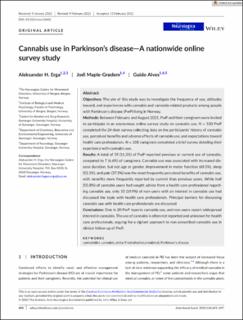| dc.contributor.author | Erga, Aleksander Hagen | |
| dc.contributor.author | Maple-Grødem, Jodi | |
| dc.contributor.author | Alves, Guido Werner | |
| dc.date.accessioned | 2022-06-20T11:02:05Z | |
| dc.date.available | 2022-06-20T11:02:05Z | |
| dc.date.created | 2022-05-23T09:17:09Z | |
| dc.date.issued | 2022-02 | |
| dc.identifier.citation | Erga, A.H., Maple-Grødem, J., Alves, G.W. (2022) Cannabis use in Parkinson’s disease—A nationwide online survey study. Acta Neurologica Scandinavica, 145 (6), 692-697. | en_US |
| dc.identifier.issn | 0001-6314 | |
| dc.identifier.uri | https://hdl.handle.net/11250/2999556 | |
| dc.description.abstract | Objectives
The aim of this study was to investigate the frequency of use, attitudes toward, and experiences with cannabis and cannabis-related products among people with Parkinson's disease (PwP) living in Norway.
Methods
Between February and August 2021, PwP and their caregivers were invited to participate in an anonymous online survey study on cannabis use. N = 530 PwP completed the 24-item survey collecting data on the participants’ history of cannabis use, perceived benefits and adverse effects of cannabis use, and expectations toward health care professionals. N = 108 caregivers completed a brief survey detailing their experience with cannabis use.
Results
A total of 59 (11.3%) of PwP reported previous or current use of cannabis, compared to 7 (6.6%) of caregivers. Cannabis use was associated with increased disease duration, but not age or gender. Improvement in motor function (69.5%), sleep (52.5%), and pain (37.3%) was the most frequently perceived benefits of cannabis use, with benefits more frequently reported by current than previous users. While half (50.8%) of cannabis users had sought advice from a health care professional regarding cannabis use, only 55 (19.9%) of non-users with an interest in cannabis use had discussed the topic with health care professionals. Principal barriers for discussing cannabis use with health care professionals are discussed.
Conclusions
One in 20 PwP reports cannabis use, and non-users report widespread interest in cannabis. The use of cannabis is often not reported and unknown for health care professionals, arguing for a vigilant approach to non-prescribed cannabis use in clinical follow-up of PwP. | en_US |
| dc.language.iso | eng | en_US |
| dc.publisher | John Wiley & Sons Ltd. | en_US |
| dc.rights | Attribution-NonCommercial-NoDerivatives 4.0 Internasjonal | * |
| dc.rights.uri | http://creativecommons.org/licenses/by-nc-nd/4.0/deed.no | * |
| dc.subject | Parkinson | en_US |
| dc.subject | cannabis | en_US |
| dc.subject | delta-9-tetrahydrocannabinol | en_US |
| dc.title | Cannabis use in Parkinson’s disease—A nationwide online survey study | en_US |
| dc.type | Peer reviewed | en_US |
| dc.type | Journal article | en_US |
| dc.description.version | publishedVersion | en_US |
| dc.rights.holder | © 2022 The Authors | en_US |
| dc.subject.nsi | VDP::Medisinske Fag: 700::Klinisk medisinske fag: 750::Nevrologi: 752 | en_US |
| dc.source.pagenumber | 692-697 | en_US |
| dc.source.volume | 145 | en_US |
| dc.source.journal | Acta Neurologica Scandinavica | en_US |
| dc.source.issue | 6 | en_US |
| dc.identifier.doi | 10.1111/ane.13602 | |
| dc.identifier.cristin | 2026328 | |
| cristin.ispublished | true | |
| cristin.fulltext | original | |
| cristin.qualitycode | 1 | |

